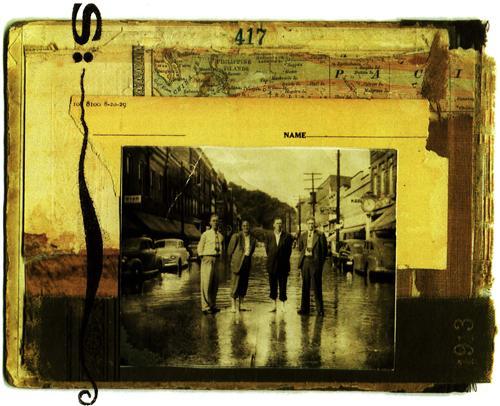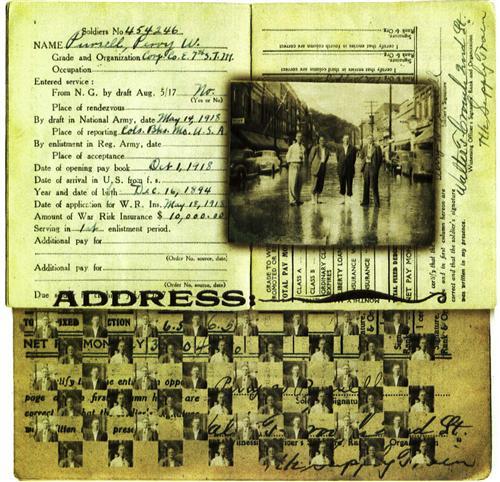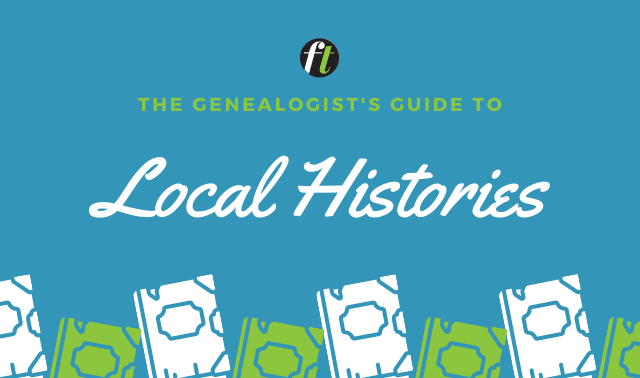Sign up for the Family Tree Newsletter Plus, you’ll receive our 10 Essential Genealogy Research Forms PDF as a special thank you!
Get Your Free Genealogy Forms
"*" indicates required fields
 Every time you discover a new fact about an ancestor — date of birth, place of marriage, military service, overseas town of origin, migration route, cause of death — you come face to face with a real-life experience. Biographical facts don’t occur out in space but rather in a real physical place at a particular moment in time. As a family historian, your goal is to situate the events of each ancestor’s life in the real world in which they unfolded. Ask yourself: How is this birth different from all the other births in my family tree? What is distinctive about this wedding? How is this immigration story personal to this ancestor? The way to personalize a biographical event is to learn all you can about it and then consider where and when it happened — that is, examine it in light of local history!
Every time you discover a new fact about an ancestor — date of birth, place of marriage, military service, overseas town of origin, migration route, cause of death — you come face to face with a real-life experience. Biographical facts don’t occur out in space but rather in a real physical place at a particular moment in time. As a family historian, your goal is to situate the events of each ancestor’s life in the real world in which they unfolded. Ask yourself: How is this birth different from all the other births in my family tree? What is distinctive about this wedding? How is this immigration story personal to this ancestor? The way to personalize a biographical event is to learn all you can about it and then consider where and when it happened — that is, examine it in light of local history!
One of the best places to find the local history that brings your ancestors’ events to life is in a published history of the county where they lived. Here you can learn the politics, families, businesses, topography, occupations, climate, natural disasters, local customs and other aspects of the county’s past. Unfortunately, though, many counties have no published history — at least, none bound together between the covers of one book. For example, there is no history of Issaquena County, Miss. But because ancestors of mine lived there, my search to understand their lives and activities revealed that sometimes historical context may be drawn from a variety of unlikely sources. Some of these sources may be familiar from your genealogy research, but you may be missing the local history that’s hidden along with the names and dates.
Here are three ways you can extract hidden bits and pieces of local history and use them for the historical context of your ancestors’ lives. These sources are readily accessible all over the country:
• official records of the Civil War
• federal studies, reports and investigations
• state histories, histories of neighboring counties and personal memoirs
Digging into the Official Records
From 1889 through 1922, the US War Department published a set of 128 volumes titled The War of the Rebellion: A Compilation of the Official Records of the Union and Confederate Armies plus a set of 30 volumes titled Official Records of the Union and Confederate Navies in the War of the Rebellion. Known simply as “OR-Army” and “OR-Navy,” these two sets constitute the most comprehensive reference available on military operations during the Civil War. The OR contains the messages, notes and reports penned by the officers in the field to their fellow officers, subordinates and superiors. Firsthand, eyewitness accounts of all campaigns and battles, strategies and results, the OR has long served family historians with fascinating insider details of their ancestors’ military service during the Civil War.
But even if you didn’t have an ancestor who fought in the Civil War, the OR can help paint a picture of America in the 1860s. These same messages, notes and reports include information about the residents and topography of thousands of neighborhoods; they mention numerous civilians by name; they describe farms, plantations and back-country terrain, manufactories, villages, towns, railroad lines, roads and highways. In short, an enormous amount of local history is hidden within the OR. This treasure is now easier than ever to mine, as the OR-Army has been put online at <www.ehistory.com/uscw/library/or>, and the OR-Navy has been put online at <cdl.library.comell.edu/moa/browse.mongraphs/ofre.html>, both with a search engine! Simply key in the name of a person or place and — voila! — up comes a listing of every page in the entire set where that name appears. Click on a link in the list, and you’re there where your ancestors were.
Issaquena County, to take just one example, is situated in the Yazoo-Mississippi Delta, today a flat expanse of cotton and soybean fields and catfish farms stretching from horizon to horizon. But that’s not what the delta looked like in the 1850s and 1860s when my ancestor George F. Ring resided on Deer Creek near Rolling Fork. Back then the delta was a network of rivers, creeks, bayous and cypress swamps, whose land was covered with dense forests rising out of a tangle of undergrowth. Only the shores of major waterways were cleared and planted; the backcountry was impenetrable. I found the most vivid evocation of the wilderness George knew in the OR.
Keying in the term Rolling Fork, Mississippi, led me to Steele’s Bayou Expedition. Although I didn’t encounter George himself, I did come across people and places this pioneer knew well. The OR allowed me to envision the rugged countryside and identify the plantations of George’s neighbors. This was the land he would turn into his economic advantage after the war, and these were the planters with whom he would conduct business to advance his mercantile career.
A couple of excerpts from the OR hint at the wealth of Issaquena County information hidden in the reports of the Steele’s Bayou Expedition. From Union officers:
Deer Creek is a narrow, sluggish stream, full of willow bushes and overhanging trees, through which nothing but keel boats have usually plied…. Its banks are usually from 1 to 3 feet above water, and the road keeps upon the river bank a natural levee.
All the country along Steele’s Bayou and Black Bayou is under water, but along Deer Creek are many fine plantations, well stocked with mules, cattle, sheep, hogs, corn, and cotton
From Confederate officers:
Colonel Ferguson had previously engaged the enemy and driven back his advance guard from Dr. Chaney’s house, immediately in the fork of Rolling Fork and Deer Creek
Considered along with other sources, the OR suggests persuasively that George F. Ring spent the war years hidden deep in the swamps of Issaquena County raising cotton, corn, cattle, hogs and chickens for the Confederate commissary! You never know what you might discover about your Civil War-era ancestors until you read the OR. You may even get lucky and find that an ancestor is singled out, like Dr. Chaney, by name. The OR also sometimes names individual soldiers and sailors, detailing the services they performed. Whether any particular ancestor is mentioned, however, the OR still provides historical context for all of your ancestors who were there then.
Asking Uncle Sam
Nothing could be duller than federal government studies, reports and investigations — unless the local history of your ancestral hometown is buried in those bureaucratic papers. For example, the United States Congressional Serial Set is a collection of more than 14,000 volumes containing House and Senate reports and documents from the 15th Congress through 1969. The reports tend to be studies and investigations conducted by congressional committees; the documents span a broad range of topics, including petitions brought before Congress by private citizens, as well as reports by executive departments and independent organizations. (The papers of the first 14 Congresses were published earlier as the American State Papers.)
Although the American State Papers and the United States Congressional Serial Set are not available online, many libraries have the microfiche edition. Even if your local library doesn’t have the microfiche, it may still have the indexes — more than two dozen volumes arranged in 12 parts to cover 180 years of material. Each part contains an index of subjects and keywords for its span of years, as well as a finding aid called “Private Relief and Related Actions — Index of Names of Individuals and Organizations.” If you find something of interest in the index, note the title as well as the Congress, session and microfiche numbers, and ask your librarian to direct you to the closest repository having the microfiche.
For years family historians have been finding genealogical clues in these federal papers. But not finding a particular ancestor’s name in the US Serial Set Index doesn’t mean there’s nothing of value for your family history here. These 14,000 volumes are chock full of information about people, places and events throughout the country.
Searching the index for the name Ring, for example, I found nothing. But searching under Mississippi resulted in a tremendously rich source of Issaquena County history: Mississippi in 1875: Report of the Select Committee to Inquire into the Mississippi Election of 1875, with the Testimony and Documentary Evidence. Senators interviewed dozens of Mississippians, whose lengthy testimony provides a vivid picture of their communities during the decade following the Civil War. I found interviews with former slave Henry P. Scott, who was sheriff of Issaquena County at the time, and other neighbors of Ring, including his attorney, W. D. Brown. Discussed at length were a freedman, Noah B. Parker, justice of the peace in my ancestor’s neighborhood, and a host of events there.
Excerpts from the testimony of just one witness demonstrate what a deep well of information Mississippi in 1875 holds about Issaquena County:
W. D. Brown — sworn and examined
Q. What is your occupation? — A. I am engaged in planting; I am also an attorney at law.
Q. What is the chief crop of your country, sir? — A. Cotton is the chief product.
Q. To clean the lint from the seed you must take it to the gin-house? — A. You must take it to the gin-house; yes, sir.
Q. Is the packing-press, the baling-press, near by there? — A. It is generally inside the gin-house now. The old-fashioned press was exterior to the gin; the press is now in the rear portion of the gin-building …
Q. In these isolated houses, do the people have any means of extinguishing a conflagration when it is once started? — A. We have nothing to depend upon. That mode of revenge is regarded as the surest…
The Rings often engaged Brown’s legal services, yet when their neighbors were arrested in connection with the destruction by fire of the Ring & Co. store and the deaths of five people sleeping in the living quarters upstairs, Brown represented the defendants!
Given the colossal size and breadth of the United States Congressional Serial Set, chances are good you’ll come up with some document containing information about the neighborhood of your forebears. You may also really get lucky. If an ancestor, through his or her senator or congressman, petitioned the US government for something — a widow’s pension or financial reparations for some grievance against a federal agent — that ancestor’s name will appear in the index, and the petition will appear in the set.
Turning other pages from history
When there’s no published history for your ancestors’ county, state histories become more vital than ever. These usually contain at least a thumbnail history of every county in the state, as well as biographical sketches of leading citizens — one of whom may turn out to be your ancestor’s neighbor, business partner, employer, physician or lawyer. Check your local library, or see the Web sites listed at right to start finding state histories, plus those of neighboring counties.
For my Ring family, I benefited from Biographical and Historical Memoirs of Mississippi, published in 1891. It covers Issaquena County in one page, but even that little bit helped. In addition, one of the biographies features the local doctor, William I. Chaney, whom we’ve already encountered in the OR. The advance guard of a Union force had set up camp in his house “immediately in the fork of Rolling Fork and Deer Creek,” the book says:
[Two Confederate generals] landed at the mouth of Rolling Fork with about two thousand eight hundred troops, where they were met by Dr. Chaney, who piloted them overland to Rolling Fork…. At daybreak on the 26th, while the Federals were lying about the lawn sleeping, about thirty Confederate sharpshooters were picketed by Dr. Chaney, and as soon as it was light enough opened fire on the Federals, … taking them by complete surprise. They at once fled to their gunboats
How odd that the OR failed to mention Dr. Chaney’s crucial role in the Steele’s Bayou Expedition. Or could it be that the physician’s memory enlarged his own role a bit over the years?
You may learn from a state history that your ancestors’ county shared much in common with a neighboring county for which a history does exist. For instance, Biographical and Historical Memoirs of Mississippi explains that Issaquena County was typical of all Yazoo-Mississippi Delta counties. One such county, where George F. Ring would establish his favorite plantation, Saints’ Rest, was Sunflower County, for which an excellent history is available — Fevers, Floods and Faith: A History of Sunflower County, Mississippi, 1844-1976 by Marie M. Hemphill, published in 1980 by the Sunflower County Historical Society.
Reading about Sunflower taught me a great deal about Issaquena. The earliest settlers were planters from out of state. Their slaves cut down the dense forests to allow for planting cotton and burned out the cane-brakes, choking the waterways so the cotton could be shipped downriver to Vicksburg. Like George Ring, the white residents beyond the reach of Union forces continued to thrive during the Civil War, raising crops and livestock for the Confederacy. Railroad lines began to pierce the cypress swamps in the early 1880s. Fevers, Floods and Faith even mentions George by name a few times:
If any one man could be considered the founder of Holly Ridge, however, it would be George Ring. Described by old settlers in the village as a “Dutchman,” Mr. Ring seems to have been a prominent citizen…. For a time Mr. Ring lived at Frazier near Shaw, later moving to Saints’ Rest Plantation, two miles north of Heathman.
It appears from his nickname, “Dutchman,” that George, a German speaker from Lorraine, France, never lost his accent.
Sometimes, though there’s no history of your ancestral county, you may find letters or memoirs penned by residents of that county or a neighboring county that shed light on the world in which your ancestors lived. Such personal papers may be found in the local historical society, perhaps even the state archives; sometimes they’ve been published and are easily accessible in libraries. Fortunately, for my history of the Ring family, the autobiography of a remarkable woman who lived in Sunflower County during the 1880s and 1890s was published in 1992 by the University of Mississippi Press — Trials of the Earth: The Autobiography of Mary Hamilton edited by Helen Dick Davis.
Living in shacks and tents, Mary and Frank Hamilton raised their five children in lumber camps that moved deeper and deeper into the wilderness as the parallel rails pushed deeper and deeper into Sunflower County. The day-to-day occupations of Mary Hamilton, the challenges she faced, the hardships she endured, mirror those of other delta pioneers of her time and place, including my Ring ancestors.
Mary Hamilton remembered:
One day he [Mary’s little brother] was hunting and heard something in a felled treetop. He thought it was a deer and went slipping along with his gun, ready to shoot. He stepped up on the tree, peeped over, and looked straight into the face of a great big bear playing with her cubs, not five feet from him. As he saw her, she saw him. He dropped his gun right down among them, turned and ran yelling for Frank every step of the way.
But the bears didn’t bother me like the panthers and the wolves did. I never could get used to hearing a panther scream, nor wolves howl, though it was an every-day occurrence.
The railroad cutting across Sunflower County would serve Ring well for transporting his cotton from Saints’ Rest to a port on the Mississippi. It’s even possible that the Rings knew or at least knew of Mary and Frank Hamilton and their children. It’s even possible the Rings heard the screaming of the panthers and wolves, as well.
Even though there were no published histories of Issaquena County, I was able to use these hidden sources to research the story of my Ring ancestors. Now my story of the Ring family, bound together between the covers of one book, Only a Few Bones (Direct Descent), is the de facto published history of Issaquena County. Your own family history could do the same for your ancestors’ county!
ON THE BOOKSHELF
• Artifacts and the American Past by Thomas Schlereth (Altamira Press): Discusses how photography, mail-order catalogs, old maps, historic house museums and other kinds of artifacts may be used to learn more about the past.
• Bringing Your Family History to Life through Social History by Katherine Scott Sturdevant (Betterway Books): How to use oral tradition, family artifacts, public and private records, and published histories to research ancestors beyond biographical statistics.
• Putting Family History into Historical Context, a special issue of the National Genealogical Society Quarterly, volume 88, no. 4, December 2000 (order from <www.ngsgenealogy.org>): Four articles focus on researching ancestors and narrating their stories within the proper historical context.
• Voices in Your Blood: Discovering Identity through Family History by G. G. Vandagriff (Andrews and McMeel): How to develop an impression of an ancestor’s personality from standard genealogical sources, photographs and other memorabilia.
• Writing the Family Narrative by Lawrence P. Gouldrup (Ancestry): How to write up your research findings into a readable, entertaining and informative family history.
FIND IT ON THE WEB
To learn what published histories exist for your ancestors’ counties and to find state histories and those of neighboring counties:
• Library of Congress
• Family History Library
• US Genweb Project
ADVERTISEMENT





